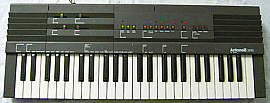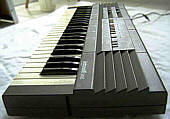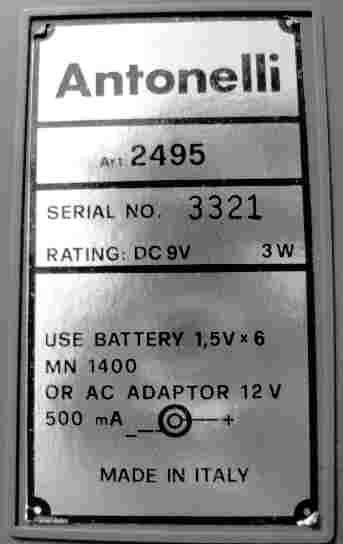 |
 |
This Antonelli keyboard from 1988(?) was technically more modern than the analogue Antonelli 2381, but still was behind its time as it had only 10 preset sounds and analogue percussion although it had already MIDI and a changeable key split point. Great is the versatile accompaniment with arpeggio.
 |
 |
Antonelli apparently made only few different instrument models, but these always were somewhat different than others and often had unusual accompaniment features.
 |
 The
4 digit serial number 3321 hints that only quite small quantities of this
instrument were built. The
4 digit serial number 3321 hints that only quite small quantities of this
instrument were built. |
The main voice presets seem to be digital waveforms filtered through capacitors. I am not sure if they are natural waveform samples or multipulse squarewave with some clever analogue filters. At least they sound more natural and nobler than the obvious squarewave timbres of Antonelli 2381, but although they are labelled "digital pcm presets", the timbres are still quite warm, which may be also caused by a small dose of analogue distortion (especially during chords). The volume envelopes seem to be digital, because decaying notes partly turn buzzier and stop a little sudden, which hints to a low DAC bit resolution. The "jazz organ" is a Hammond timbre (might be a filtered multipulse squarewave) without key click. The "pipe organ" is brighter and has a slower attack phase. The "piano" sounds like a well filtered squarewave timbre and gets somewhat brassy in the bass range. The "guitar" sounds like a differently filtered variant of it, which timbre is more like a harp. The "e.piano" shall be likely a Rhodes imitation and contains some glassy aliasing(?) overtones; in the bass range it gets a little buzzy, similar like the squarewave based Consonant Vowel timbres of early Casio keyboards (see CT-410V). The "strings" has a quite realistic violin timbre with slow fading attack phase and vibrato. The "flute" might be a differently filtered version of "strings"; it has the same envelope and vibrato, but a dull flute timbre which slightly resembles a theremin and resembles a tuba in the bass range. The "accord." is a quite natural accordion timbre that seem to use the same filter like "strings". The "trump." sounds more like a dull and slightly creaky oboe or cello than a trumpet; it contains vibrato and resembles somewhat a C64 timbre. The vibrato of the sounds seems to modulate the CPU clock oscillator, because it always also affects the accompaniment section. With the "sustain" button the release phase of the preset sounds can be prolonged. The keyboard can be transposed within 1 octave by pressing "transp." together with a piano key.
The analogue percussion sounds like typical home organ drums. There is a fill-in button (labelled "intro break") and instead of the rhythm also a "metronome" can be played, which consists of a knocking base with a tom drum on the 1st step. Unfortunately unlike with Antonelli 2381 the metronome here can not be combined with the automatic accompaniments of the rhythms (instead it switches into manual chord mode) and it also doesn't react on rhythm "start stop" and fill-in buttons. Interesting is that when "key start" and not "start stop" is pressed, the rhythm plays only so long any key in the accompaniment section is held down. It stops by releasing these keys and always restarts the pattern by pressing an accompaniment key. This way some weird breakbeat stuff can be played by trilling on the keys. With the tempo knob the rhythm tempo can be set very low but not extremely high. A bit strange is that the metronome sometimes starts itself when the instrument is not played for some minutes; I am not sure if this is a defect or if it was intended as a battery saving alarm. (Like most battery alarms it starts also with AC- adapter.)
The accompaniment here has a lot of features, those controls have partly odd names. E.g. when "bass" is pressed, the lowest note played in the left section of the keyboard is layered with a monophonic bass and this works not only with accompaniment or chord mode, but also with the normal melody voice. The bass is a soft and warm organ bass with sustain that sounds quite analogue. When "split & chords" is pressed, the left keyboard section plays a different sound that depends on the selected rhythm (also with rhythm off). These sounds correspond to the 10 main voice preset sounds except that they contain no vibrato (likely because vibrato is implemented by modulating the clock oscillator); even the sound number corresponds to the rhythm number (i.e. to select the 3rd sound "guitar", select the 3rd rhythm "country"). The key split also serves the purpose of a "fingered chord" mode; the only main difference is that you can use the full polyphony here. When "memory" is pressed, the current chord or key combination in the left section is held after releasing the keys until any new key is pressed. To change the key split point, press simultaneously "kbd select" and "transp." together with the intended key. (But the split point seems to be still only placeable within the 2nd keyboard octave). To enable the single finger chord, as well "O.F.C." as "split & chords" have to be pressed (both LEDs lit). To enable the automatic accompaniment, the button "modul." has to be pressed and a rhythm started. When "modul." is not pressed, the rhythm is simply combined with the normal manual chord (key split or single finger chord), thus this instrument does not urge you to use the automatic accompaniment but you can still play normal organ chord in the left keyboard section together with a rhythm. (Although this technically simple feature should be a matter of course and was available in most early home organs, it exists only in very few modern home keyboards.) You can even combine the arpeggio with manual chord play. The arpeggio plays a sort of banjo timbre while the chord timbre of the accompaniments depend on the rhythm they belong to. (The bass timbre of accompaniments stays always the same.) But in comparison to the cute and cheesy sounding Antonelli 2381, the 2495 sounds braver and more establishment- like, not least because the arpeggios of the 2495 are more generic. Each accompaniment is formed by a characteristic monophonic bass line and a rather generic arpeggio (both can be switched off), but it does not recognize chords in any way nor does it strum or otherwise melodically re-arrange the held notes from the accompaniment section into a complex pattern, but simply chops these notes rhythmically by the selected rhythm. This makes the accompaniments quite boring (the Antonelli 2381 had more complex arpeggios and 2 variations per rhythm), but great is that you can play here instead of chords any weird disharmonic note clusters those get also gated by the accompaniment into a wildly grunting sound.
There is also a "sequencer rec. play" button and a "sequencer write" function on the keyboard, but I haven't figured out yet what it does. In the catalogue stands that it can store 12 OFC (i.e. single finger) chords for the accompaniment, thus it is likely a chord sequencer. Instead of 2 MIDI jacks there is only a single 5 pin DIN jack labelled "serial in-out" and on the keyboard is a function "serial rate" that can be switched between "MIDI" and "RS232". Likely it could be connected through special cables either with a PC serial port or MIDI devices, but I haven't tried this yet. (Does anybody know more about this?) The predecessor Antonelli 2381 had only a walkman type jack for a PC serial port.
The demo repeats "When the Saints Go Marching In" in a loop with pipe organ timbre, standard accompaniment and arpeggio, but in comparison with the analogue predecessor Antonelli 2381 the jazzy intermezzo is gone and it not even cycles through different preset sounds, which makes the tune quite boring.
A larger stereo variant of the Antonelli 2495 (direct predecessor?) was the Antonelli 2614. A more archaic keyboard with nice arpeggios was the analogue Antonelli 2381.
Wanted: I am searching for the historical
PC connection software (DOS drivers?) that came with or was sold for the
Antonelli
2495 keyboard. Does anybody has this software (original or copy) or
the special cable or at least some info about these?
| removal of these screws voids warranty... | ||
 |
||
|
|